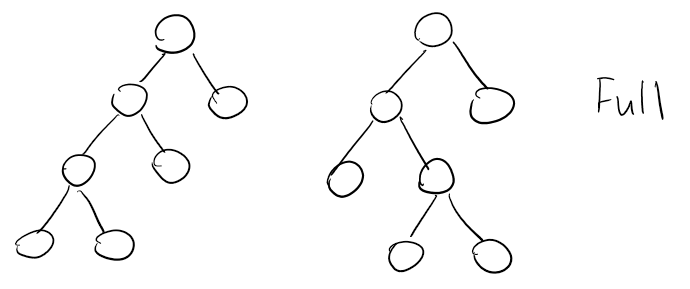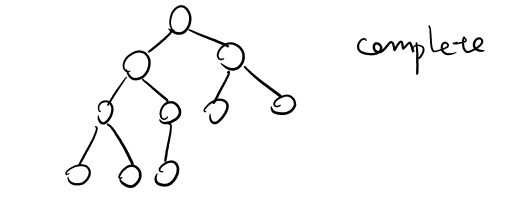Data Structure (2) - Tree & Traversal
Tree
A tree is an acyclic graph ( a graph that has no circle in it)
Tree ADT
ADT: Abstract Data Type
- insert: add data (node) to tree
- remove: remove data (node) from tree
- create: create empty tree
- traversal: iterate over data
// BinaryTree.h
#pragma once
template <typename T>
class BinaryTree {
public:
/*....*/
private:
struct TreeNode {
T data_;
TreeNode * left;
TreeNode * right;
}
TreeNode * root_;
}Binary Tree
A binary tree is either:
- T = {root, TL, TR} A root, plus a left tree, plus a right tree. Or
- An empty set (empty tree / tree with no node)
Tree Property: Height
Definition
Length of the longest path from the root to a leaf.
Note
- Count only the path (arrows), not the nodes.
- If the tree has k layers, it's height h = k-1.
- The height of an empty tree is -1.
- The height of a tree with only one node is 0.
Calculation
height(T) = max(height(TL), height(TR)) + 1
Maximum number of nodes a binary tree of height h can have:
m(h) = 2(h+1)-1
Minimum height of a tree with n nodes: log(n)

Tree Property: Full
A tree is full if and only if:
- The tree is empty
- F = {root, TL, TR} where TL and TR are both empty
- or TL and TR are both not empty
In simple terms, each node has 0 or 2 children.

Tree Property: Perfect
Let P(h) be a perfect tree of height h, then:
- P(-1) is an empty tree
- P(h) = {r, TL, TR} where TL and TR are P(h-1)
All perfect trees are full and complete, but not all full trees are perfect.

Tree Property: Complete
Definition
A perfect tree for every level except the last, where the last level if "pushed to the left".
For all levels k in [0, h-1], k has 2^k nodes. For level h, all nodes are "pushed to the left"
A complete tree C of height h, C(h):
- C(-1) is an empty tree
- When h>=0, C(h) = {r, TL, TR} and either:
- TL is C(h-1) and TR is P(h-2) — when left is not filled, right can't have last layer of leaves, but right must be a (h-2) perfect tree
- or
- TL is P(h-1) and TR is C(h-1) — when left is filled, right can fill up to h-1

How many null pointers does a binary tree of n nodes has?
Theorem: If there are n data items in a binary tree, then there are n+1 NULL pointers.
Base Cases:
- NULLs(0) = 1 — In a tree of 1 node, there is 1 pointer, root, which is null.
- NULLs(1) = 2
- NULLs(2) = 3
Induction Hypothesis:
Suppose NULLs(n) = n+1 for 0<=n<=k
Consider an arbitrary tree T containing k nodes:
T = {r, TL, TR} (split the tree into root, left tree, right tree)
if TL has q nodes, then TR has k-q-1 nodes.
then NULLs(k) = NULLs(q) + NULLs(k-q-1)
by hypothesis,
NULLs(k) = NULLs(q) + NULLs(k-q-1) = (q+1) + (k-q-1+1) = k+1
Traversal
Traversal vs Search:
Traversal: visits every node in the tree exactly once.
Search: finds one element in the tree.
Recursive:
template <class T>
void BinaryTree<T>::PreOrder(TreeNode * cur) {
if(cur) { // checking if the node is empty
cout << cur->data << endl; // access root data
PreOrder(cur->left); // go left
PreOrder(cur->right); // go right
}
return;
}
template <class T>
void BinaryTree<T>::InOrder(TreeNode * cur) {
if(cur != NULL) {
InOrder(cur->left); // go left
cout << cur->data << endl; // access root data
InOrder(cur->right); // go right
}
return;
}
// standard infix notation in computation
// e.g. (1-(a/b))*(2+3)
// operation on root, and figures/operations on leaves
template <class T>
void BinaryTree<T>::PostOrder(TreeNode * cur) {
if(cur!=NULL) {
PostOrder(cur->left);
PostOrder(cur->right);
cout << cur->data << endl;
}
return;
}
// RPN (Reverse Polish Notation) in computation
// or stack order
// e.g. 3 4 5 * -
// that's 3-4*5
Non-recursive (level order):
- Go layer by layer
- BFS (Breadth first search)
- O(n) runtime
Steps:
- Create an empty queue and enqueue root.
- Pop queue and process where process is:
- Access data, then enqueue all child nodes.
- Repeat step 2 until queue is empty.
Depth First Search
Post/Pre/In order.
Good at finding data at the leaves. If lucky, very fast.
Most memory needed: O(h) (your stack will never gets over the height of the tree)
Breadth First Search
Level order.
Good at finding data near the root.
Most memory needed: O(2h) or O(n) (leave nodes in queue)
If key is in tree, it will find it even if the tree is infinite.
ref: https://courses.engr.illinois.edu/cs225/fa2020/
